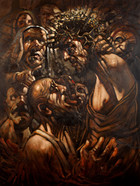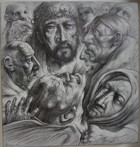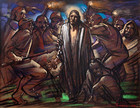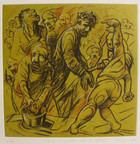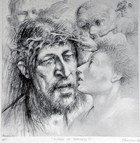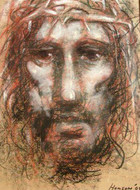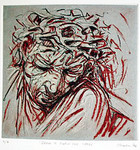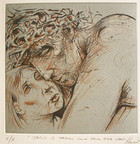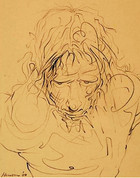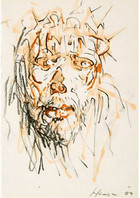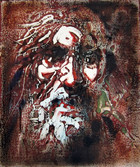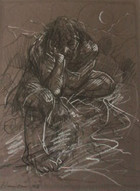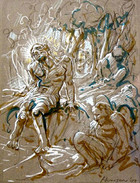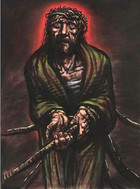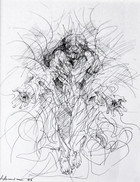Peter Howson
Looking at the early works of Scotland-based Artist Peter Howson, crowded with football hooligans, punch-drunk pugilists, street people, prostitutes, asylum inmates, alcoholics, drug addicts and, in recent years, the crucified Christ, you can’t help but hear in your head the familiar refrain from the glorious old hymn: “Amazing grace, how sweet the sound, that saved a wretch like me.” Howson is that refreshing oddity in 21st Century culture--a man of faith who knows how “amazing grace” can change a life and is not ashamed to talk about it. In a Sunday Times article in April 2003, titled “You Might Not Like it, but I’m a Christian,” he described himself as “a happy anomaly, unfashionable but more fulfilled than I have ever been.”
Howson is all too familiar with the harshly-lit, rough-and-tumble world he depicts in his paintings and drawings, and often includes self-portraits. A victim of bullying in school and in the army, he drifted in and out of art courses, spending daytime hours body-building in the gym, working nights as a bar-room bouncer. His studies of exaggeratedly-muscled, lowlife figures and his apocalyptic cityscapes eventually attracted the attention of art critics and buyers. Just when Howson was achieving fame and wealth as one of the “New Glasgow Boys,” a loose grouping of Scottish post-modernist, figurative artists, his personal life went on the skids. A traumatic stint as an official war artist in Bosnia, combined with drug and alcohol abuse, brought on what Howson described as a “sickness of the soul.”
The anguished artist was following the twelve-step recovery plan of Alcoholics Anonymous, when he experienced a religious conversion, a life-changing event he commemorated, later, in a series of works called The Third Step, depicting the moment in the AA program when addicts come to recognize their need for the help of a Higher Power. His change of heart brought him decidedly mixed reviews in secular art circles. As Howson told the Sunday Times: “It is ironic that people are more comfortable with me discussing the alcoholism and drug abuse that ruined my marriage, made my daughter’s life a living hell, and threatened to destroy my career as an artist than they are hearing about my Christian faith.” (Howson’s daughter, Lucy, who suffers from Aspergers Syndrome, is a frequent subject in his art.)
Howson’s art nowadays openly subverts contemporary art’s iconography of nihilistic violence and his own early images of rioting in the streets with a “countercultural” message of redemptive hope. In pictures like Outcast, Imposter, The Garden of Gethsemane and Jesus is Condemned to Death from Howson's lithographic cycle of the Stations of the Cross, the long-suffering image of Christ stands out amid galleries of typically Howsonian grotesques, their faces distorted by anger, suspicion, and sullen indifference, like a still point of love in a vortex of hate. In these Christocentric images you can almost sense the artist, strugging to come to terms with his own faith in a sceptical and unforgiving age.
In the years since his conversion, Howson has created a portfolio of Christ portraits in a variety of mediums unparalled in contemporary art. They range from poignant, polished studies, rich in astonishing detail like the giclee print, "What is Truth?" to the serenely expressive mixed media drawing, Head of Christ, and the jagged-edged jottings of Christ in Agony. In the monotype, Mountblow, ink seems to ooze off the paper like blood, sweat and tears. As Howson explained in a 2023 documentary film: "When I paint Jesus there are so many different facial expressions I can get. You could paint an infinity, millions, and trillions of pictures of Jesus and every single one will be different."
Howson creates Passion imagery on a grand scale, worthy of Rembrandt. In his mixed media drawing, Inferno 5, he sets the Crucifixion in a hellish urban wasteland. He is equally adept at depicting intensely private, contemplative moments like Christ in the Desert. In The Last Temptation, we see the anguished Christ in the Garden of Gethsemane, stripped down and sweating, as he prays for his cup of torment to pass. In Study for Ecce Homo, the bound Jesus envisions all the horrors to come. Whether you consider the crowd scenes or the up-close portraits, you have to go back to the works of North European Masters like Matthias Grunewald or Hieronymus Bosch to find sacred imagery with this kind of raw emotive power!
